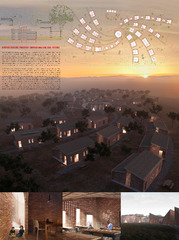Приказ основних података о документу
Africa School Project [42. Salon of Architecture]
Edukativni centar u Africi [42. salon arhitekture]
| dc.creator | Rašeta, Darija | |
| dc.creator | Spasenović, Vanja | |
| dc.creator | Simić, Mihailo | |
| dc.creator | Graovac, Ognjen | |
| dc.date.accessioned | 2023-11-23T18:00:53Z | |
| dc.date.available | 2023-11-23T18:00:53Z | |
| dc.date.issued | 2020 | |
| dc.identifier.isbn | 978-86-7415-220-1 | |
| dc.identifier.uri | https://raf.arh.bg.ac.rs/handle/123456789/1577 | |
| dc.description.abstract | Basic condition for society development and its progress is youth education. Main project idea is to create a valuable place to learn, play and live for the children of Malawi. The African school project design is inspired by traditional African architecture; principles that accentuate the spirit of community and emphasize the local heritage create a setting where the children can find a sense of joy and belonging. Anthropologists have concluded that many African societies used fractals in their architecture, spirituality and art. Keeping the African heritage alive, such logic was applied to our design idea, where the project as such is never finished and can always be developed further according to the nature of fractals. With location and sub-tropical climate parameters in mind, presented design solution offers a unique self-sustaining system for every facility. Using clay brick as the main construction material the cost of construction process is reduced and the building itself is simplified, allowing on-site construction. Double-brick walls are constructed of two brick layers with an air gap in between. Clay brick has thermal mass properties and can absorb heat and release it slowly into the objects. This slow release of heat can be great for comfort even during summer, as the house warms up during the day and cools off at night. The perforated brick-style of the outer wall allows constant natural ventilation of the facilities, eliminating the need for artificial ventilation. Solar panels on object roofs are specifically set up to receive the biggest amount of sunlight. Collected rainwater is later used to irrigate the gardens. Recycling the materials from old buildings that will be demolished on site can be used for making some of the furniture and fencing, which helps make the total cost of the construction significantly smaller. | sr |
| dc.language.iso | sr | sr |
| dc.language.iso | en | sr |
| dc.publisher | Beograd : Muzej primenjene umetnosti = Belgrade : Museum of Applied Art | sr |
| dc.rights | openAccess | sr |
| dc.source | Uporno – Otporno / 42. Salon arhitekture, Muzej primenjene umetnosti, Beograd, 10. septembar - 03. oktobar | sr |
| dc.subject | Edukacija | sr |
| dc.subject | Fraktali | sr |
| dc.subject | Škola | sr |
| dc.subject | Republika Malavi | sr |
| dc.subject | Education | sr |
| dc.subject | Fractals | sr |
| dc.subject | School | sr |
| dc.subject | Republic of Malawi | sr |
| dc.title | Africa School Project [42. Salon of Architecture] | sr |
| dc.title | Edukativni centar u Africi [42. salon arhitekture] | sr |
| dc.type | archWork | sr |
| dc.rights.license | ARR | sr |
| dcterms.abstract | Граовац, Огњен; Симић, Михаило; Рашета, Дарија; Спасеновић, Вања; Едукативни центар у Aфрици [Изложба: 42. салон архитектуре]; Едукативни центар у Aфрици [Изложба: 42. салон архитектуре]; | |
| dc.citation.spage | 153 | |
| dc.citation.epage | 153 | |
| dc.identifier.fulltext | http://raf.arh.bg.ac.rs/bitstream/id/5383/bitstream_5383.pdf | |
| dc.identifier.rcub | https://hdl.handle.net/21.15107/rcub_raf_1577 | |
| dc.type.version | publishedVersion | sr |

